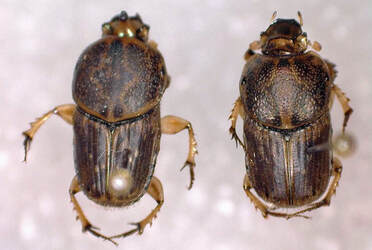|
By Mackenzie Miller During these summer months, having control over flies can be difficult. All flies are pests, but there are different species of flies that you should be aware of. Not all fly control methods will work for all three species. Horn flies are blood-sucking pests that stay on cattle continuously, leaving only when disturbed or when they move to fresh manure to deposit their eggs. Horseflies are severe blood-sucking pests that irritate cattle by feeding on them. Controlling horseflies is especially difficult since they spend little time on the cattle. Face flies usually feed on the mucus secreted from the eyes of cattle. They spread the bacteria that can cause pinkeye. There are several methods you can use to control flies around your cattle. We will only touch on a few different options for both chemical methods and non-chemical methods to control flies. Chemical Methods (insecticides)1. Ear tags - Insecticide ear tags are an easy way to control horn flies and face flies on your cattle. They give the best fly control when you use two tags per animal. Apply them to all of your herd in late May or early June and remove them in September/October. 2. Back rubbers - If you don't want to deal with the hassle of having to tag each animal, back rubbers are a great option to control horn flies. You can purchase pre-assembled back rubbers or can take the DIY (do it yourself) approach. Back rubbers should be placed in an area where cattle will frequently walk through it. They are more effective against face flies if you add 18 inch strips of cloth, tied at four to six inch intervals along the length of the back rubber. The strips of cloth are soaked in insecticide and tied to the back rubber. Photos from Dan Miller Non-chemical Methods1. Dung beetles - Manure is a breeding ground and incubator for horn and face flies. Dung beetles are drawn to manure by the odor. They use the liquid contents of the manure fr their nourishment. As dung beetles feed on manure, they compete with the fly larvae for food and physically damage the flies' eggs. A study from the University of Florida was conducted on dung beetles and their role in the cattle industry. The study notes that there are already large populations of dung beetles established on farms where livestock have been continuously raised. Rotational grazing and woodland adjacent to pastures should help in increasing local dung beetle population within the pasture. To read more about the benefits of dung beetles, check out this article from Gallagher 2. VitaFerm HEAT - This BioZyme product is intended to combat heat stress, but it also contains garlic. The garlic serves as a natural insect repellent as the smell repels insects through breath and skin excretion. It's available in both tub and loose mineral form. Click here to view these products 3. Parasitic Wasps - Parasitic wasps require fly eggs to complete their reproductive cycle. They use their stinger to lay eggs in the pupae of flies. These eggs then hatch and feed on the fly larvae and emerge as adults after about two weeks. The wasps take about 3 weeks to complete a generation, so multiple releases of wasps during fly season is more successful than releasing them all at once. You can purchase parasitic wasps from an insectary.
Comments are closed.
|
Archives
June 2024
Categories
All
Welcome |
CONTACT US |
EMAIL SIGN UP |
|
Eden Shale Farm
245 Eden Shale Rd. Office: (859) 278-0899 Owenton, KY 40359 Fax: (859) 260-2060 © 2021 Kentucky Beef Network, LLC.. All rights reserved.
|
Receive our blog updates
|





 RSS Feed
RSS Feed
